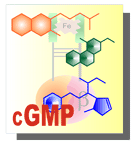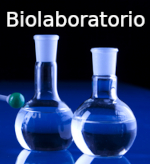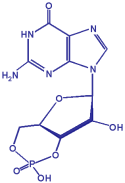
© Blauplanet.com
Other sections:





Cyclic GMP
Tools
Created by Dr. Luis Agulló (last update on 12-6-2007)
Inhibitors of Soluble Guanylyl/Guanylate Cyclase
Methylene blue
[3,7-bis(Dimethylamino)phenothiazin-5-ium]
Potency: -
Membrane permeability: N / Solubility: H2O / MW: 319.8
Comments: Staining agent; organic spin-trap agent1.
CAUTION: Not a true inhibitor of guanylyl cyclase. It acts as a cGMP lowering agent. It prevents nitrodilator-dependent activation of soluble guanylate cyclase by generating oxygen radicals. In fact, methylene blue does not enter into the cells unless membrane is permeabilized2. It has been described to inhibit NO release3.
1Inhibitor SourceBook, Calbiochem, Merck Biosciences
2Kontos HA, Wei EP. Hydroxyl radical-dependent inactivation of guanylate cyclase in cerebral arterioles by methylene blue and by LY83583.. Stroke 1993;24:427.
3Mayer B, Brunner F, Schmidt K. Inhibition of nitric oxide synthesis by methylene blue. Biochem Pharmacol 1993;45:367.
LY-83583
[6-anilino-5,8-quinolinedione]
Potency: IC50= 2 µM1.
Membrane permeability: Y / Solubility: EtOH / MW: 250.2
Comments: Not a true inhibitor of guanylyl cyclase. In fact, it has been shown to increase enzyme activity in a cell-free preparation. The mechanism by which LY83583 reduces the concentration of cGMP is presently unknown, although (as for methylene blue) it has been shown to prevent the activation of soluble guanylate cyclase by nitrodilators or by calcitonin gene-related peptide by the generation of oxygen radicals1,2.
2Kontos HA, Wei EP. Hydroxyl radical-dependent inactivation of guanylate cyclase in cerebral arterioles by methylene blue and by LY83583. Stroke 1993;24:427.
CAUTION: Only a cGMP lowering agent; it inhibits NO release.
1Mulsch A, Busse R, Liebau S, Forstermann U. LY 83583 interferes with the release of endothelium-derived relaxing factor and inhibits soluble guanylate cyclase. J Pharmacol Exp Ther 1988;247:283.
ODQ
[1H-[1,2,4]Oxadiazolo[4,3-a]quinoxalin-1-one]
Potency: IC50= 20 nM1,2
Membrane permeability: Y / Solubility: DMSO / MW: 187.2
Comments: Irreversible inhibitor. Nowdays, ODQ is probably the drug of election when it is required to differentiate cGMP-mediated effects of NO from cGMP-independent effects. More information about the use of this drug can be found in references 3 and 4.
2Inhibitor SourceBook, Calbiochem, Merck Biosciences
3Moro MA, Russel RJ, Cellek S, Lizasoain I, Su Y, Darley-Usmar VM, Radomski MW, Moncada S. cGMP mediates the vascular and platelet actions of nitric oxide: confirmation using an inhibitor of the soluble guanylyl cyclase. Proc Natl Acad Sci USA 1996;93:1480.
4Schrammel A, Behrends S, Schmidt K, Koesling D, Mayer B. Characterization of 1H-[1,2,4]oxadiazolo[4,3-a]quinoxalin-1-one as a heme-site inhibitor of nitric oxide-sensitive guanylyl cyclase. Mol Pharmacol 1996;50:1.
CAUTION: ODQ act also as an inhibitor of the biotransformation of NO donors (of those requiring such transformation, like glycerol trinitrate -GTN- and sodium nitroprusside -SNO-), probably by its inhibitory effect on P-450-like proteins1. On the other hand, ODQ could bind to myoglobin. Then, its effects could be 'emmascarated' in tissues as myocardium with a high content of this protein2. ODQ inhibits soluble guanylyl cyclase apparently by oxidation of the heme group of the enzyme. It also oxidize hemoglobin and could affect other heme containing proteins by the same mechanism3.
1Feelisch M, Kotsonis P, Siebe J, Clement B, Schmidt HH. The soluble guanylyl cyclase inhibitor ODQ is a nonselective heme protein inhibitor of NOS and other cytochrome P-450 enzymes involved in NO donor activation. Mol Pharmacol 1999;56:243.
2Wegener JW, Closs EI, Forstermann U, Nawrath H. Failure of 1H-[1,2,4]oxadiazolo[4,3-a]quinoxalin-1-one (ODQ) to inhibit soluble guanylyl cyclase in rat ventricular cardiomyocytes. Br J Pharmacol 1999;127:693.
3Zhao Y, Brandish PE, DiValentin M, Schelvis JP, Babcock GT, Marletta MA. Inhibition of soluble guanylate cyclase by ODQ. Biochemistry 2000;39:10848.
NS 2028
[4H-8-Bromo-1,2,4-oxadiazolo(3,4-d)ben(b)(1,4)oxazin-1-one]
Potency: IC50= 17-200 nM for basal or stimulated sGC1
Membrane permeability: - / Solubility: DMSO, EtOH / MW: 269.0
Comments: Irreversible inhibitor. Chemically similar to ODQ.
CAUTION: -


Author: Dr. Luis Agulló (luis.agullo [at] lagullo.com).
Edited by Blauplanet.com, Cerdanyola del Vallès, Barcelona, Spain.
Webmaster: info [at] blauplanet.com. Conditions of use.